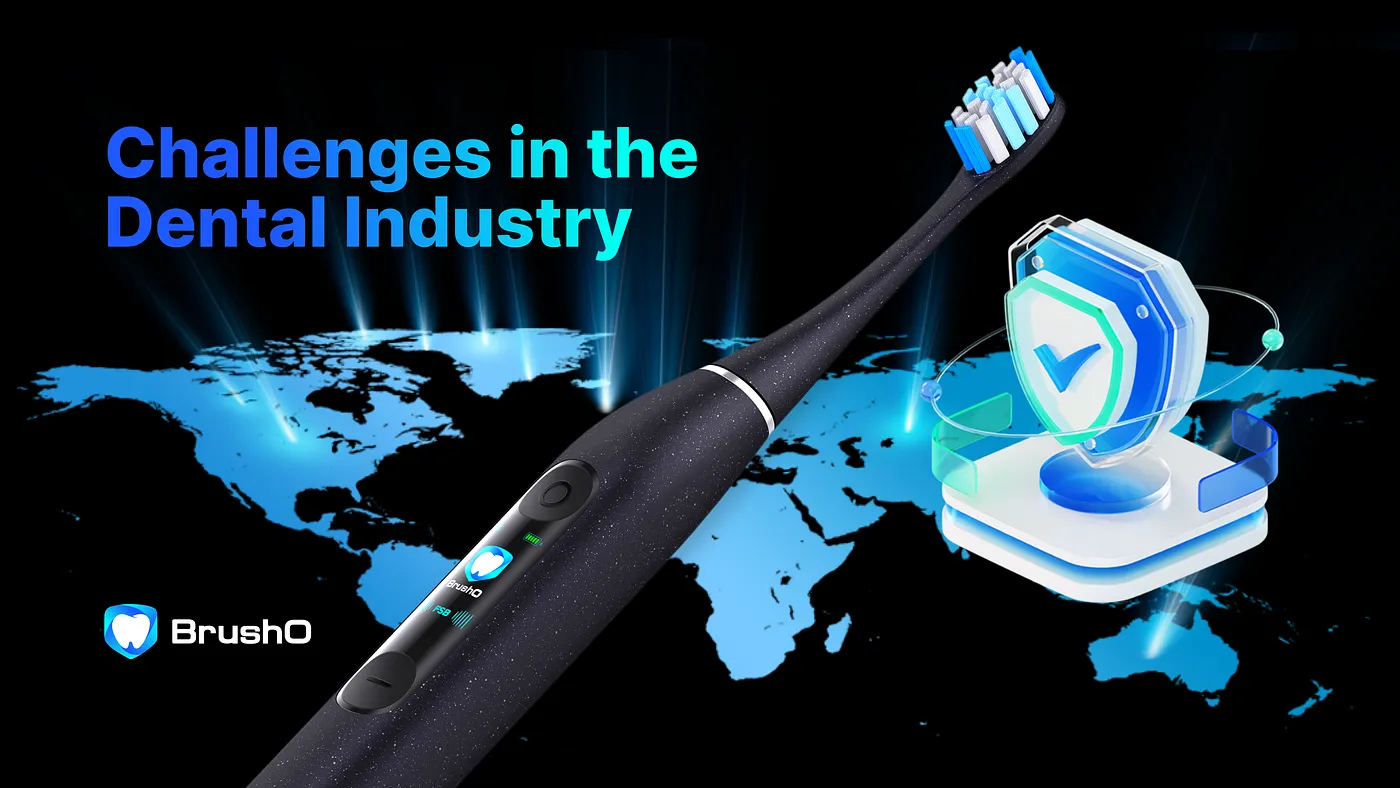Popular
How to Build the Perfect Oral Care Routine in 2025
Jul 30
Why Your Gums Bleed and How to Fix It Fast in 2025
Jul 30
Top 5 Oral Care Mistakes You are Probably Making And How BrushO Fixes Them
Jul 29
What Makes a Toothbrush “Smart”?
Jul 22
BrushO Smart Toothbrush: Gentle, Powerful, Travel-Friendly
Jul 19
BrushO: The Future of Smart Oral Care—Redefining the Way You Brush
Jul 17
Back
The Global Dental Crisis: Challenges, Solutions, and the Future of Oral HealthFeb 28
Feb 28
The world dental market is experiencing major change, driven by advances in technology, changes in patient expectations, and financial pressures. As of 2024, the market size was around $37.86 billion, and it is expected to expand to $87.65 billion by 2032, with a CAGR of 11.5%.

Key Challenges in the Dental Industry:
- Rising Operational Costs:
- Inflation and Supply Charges: Dental clinics worldwide are facing a rise in supplies and equipment costs. In mid-2022, dental service prices jumped by almost 2% in a single month, the biggest single-month increase on record.
- Employee Expenses: Attractive salaries and benefits are required to recruit and retain skilled dental professionals, placing additional pressure on practice budgets.
2. Workforce Shortages:
- Dental Hygienists and Assistants: A 2024 report identified dental hygiene program bottlenecks, with acceptance rates falling to 25% from 31% a decade earlier. The shortage is compounded by the closure of numerous hygiene programs and strict acceptance standards.
- Geographical Disparities: Large metropolitan areas are more likely to have a greater concentration of dental professionals, but rural and underserved communities experience severe shortages, limiting access to care.
3. Evolving Patient Expectations:
- Call for Advanced Technology: Patients increasingly anticipate cutting-edge solutions like AI-based diagnostics, teledentistry, and customized treatment plans. Practices must invest in these technologies to keep pace with patient expectations and stay competitive.
- Cosmetic Dentistry Trends: Social media and celebrity culture have given birth to a popularity drive for cosmetic treatments such as veneers. The trend, however, is causing concern regarding the possible health consequences of changing healthy teeth, particularly among younger patients.
4. Economic Barriers to Patient Care:
- Cost-Prohibitive Services: In the UK, 41% of adults identify cost as the biggest reason for not receiving dental treatment. This economic barrier causes most people to delay or avoid the treatment they need, worsening their oral health problems.
- Insurance Restrictions: In America, over 68 million individuals do not have dental insurance, and one out of every four adults will not go to the dentist because they cannot afford it.
Global Perspectives:
- United States: Lacks more than 10,000 dentists and is projected to have a shortage of more than 36,000 dental professionals by 2031. The shortage affects the accessibility of care, particularly among the disadvantaged.
- United Kingdom: The NHS state dentistry is in crisis with a record low of 40% of the adults having visited an NHS dentist in the last two years up to March 2024. The reduction in dental care available is due to increasing operational costs and the absence of government funding.
- Australia: Approximately 4 in 10 adults have avoided or delayed dental treatment because of cost, a measure of dental care cost barriers.
Technological Advancements and Opportunities:
- Artificial Intelligence: AI is transforming dentistry by facilitating earlier detection of dental problems, automating administrative processes, and improving patient care through customized treatment plans
- Teledentistry: The use of teledentistry has increased access to care, especially in underserved communities, by enabling remote consultations and follow-ups
- Dental Support Organizations (DSOs): The growth of DSOs provides the practice with the ability to expand operations, reduce risk, and gain access to sophisticated technologies, alleviating some of the operational difficulties experienced by independent practices
To address these complex problems, BrushO is leading the way with a new oral health care approach by combining cutting-edge technologies and consumer-focused solutions:
- AI-Powered Toothbrushes: BrushO created an AI-Powered Toothbrush that features sophisticated sensors and patent-pending Fully Smart Brushing (FSB) technology. The toothbrush monitors in real time and provides personalized feedback for optimal brushing technique and early identification of possible dental problems.
- Decentralized Health Data Platform: Based on blockchain technology, BrushO allows users to develop and control their own Web3 Oral Health ID. Being decentralized, it protects user privacy, gives individuals ownership of their health data, and provides easy sharing with dental professionals, thus improving coordinated care.
- Global Access and Equality: BrushO is at the forefront of AI and blockchain innovation in dental health, striving to bridge the gap in oral care accessibility. By leveraging cutting-edge technology, BrushO aims to provide high-quality dental solutions to underserved communities, ensuring a healthier future for all.
In summary, the dental market is navigating a delicate path shaped by increasing costs of doing business, staff shortages, and shifting expectations among patients. Cutting-edge answers such as provided by BrushO are the way to mitigate all this.
The future holds promise of an enhanced, more level oral health care system, being efficient and centered around patients by welcoming technology and establishing worldwide cooperation.
About BrushO:
BrushO is redefining oral health with AI-powered smart brushing and Web3 integration. Our ecosystem allows users to track brushing habits, receive real-time feedback, and own their health data securely. Through the Web3 Oral Health ID, users can control and even monetize their brushing data with $BRUSH rewards.
By combining AI, blockchain, and decentralized technology, BrushO is leading the future of smarter, healthier oral care.
🌐 Website: www.brusho.io
📩 Community: www.t.me/brushocommunity
Popular
How to Build the Perfect Oral Care Routine in 2025
Jul 30
Why Your Gums Bleed and How to Fix It Fast in 2025
Jul 30
Top 5 Oral Care Mistakes You are Probably Making And How BrushO Fixes Them
Jul 29
What Makes a Toothbrush “Smart”?
Jul 22
BrushO Smart Toothbrush: Gentle, Powerful, Travel-Friendly
Jul 19
BrushO: The Future of Smart Oral Care—Redefining the Way You Brush
Jul 17
